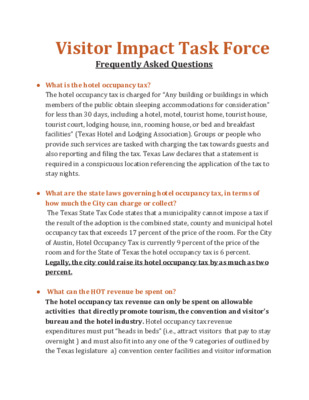Visitor Impact Task Force FAQ Fact Sheet — original pdf
Backup

Visitor Impact Task Force Frequently Asked Questions ●What is the hotel occupancy tax? The hotel occupancy tax is charged for “Any building or buildings in which members of the public obtain sleeping accommodations for consideration” for less than 30 days, including a hotel, motel, tourist home, tourist house, tourist court, lodging house, inn, rooming house, or bed and breakfast facilities” (Texas Hotel and Lodging Association). Groups or people who provide such services are tasked with charging the tax towards guests and also reporting and filing the tax. Texas Law declares that a statement is required in a conspicuous location referencing the application of the tax to stay nights. ●What are the state laws governing hotel occupancy tax, in terms of how much the City can charge or collect? The Texas State Tax Code states that a municipality cannot impose a tax if the result of the adoption is the combined state, county and municipal hotel occupancy tax that exceeds 17 percent of the price of the room. For the City of Austin, Hotel Occupancy Tax is currently 9 percent of the price of the room and for the State of Texas the hotel occupancy tax is 6 percent. Legally, the city could raise its hotel occupancy tax by as much as two percent. ● What can the HOT revenue be spent on? The hotel occupancy tax revenue can only be spent on allowable activities that directly promote tourism, the convention and visitor's bureau and the hotel industry. Hotel occupancy tax revenue expenditures must put “heads in beds” (i.e., attract visitors that pay to stay overnight ) and must also fit into any one of the 9 categories of outlined by the Texas legislature a) convention center facilities and visitor information centers b) convention registration c)advertising the municipality and its vicinity as a destination to attract visitors d) promotion of the arts e) historical restoration f) sporting events in county with under one million in population g) enhancing or upgrading existing sports facilities or sports fields (only in certain cities) h)tourist transportation systems and i) signage directing the public to sights and attractions that are visited frequently by hotel guests in the city. ●How are we spending hotel occupancy tax dollars now? Currently the hotel occupancy tax is split into four parts. Of the 9 percent City of Austin charges, 1.05 percent is allocated to the cultural arts, 4.50 percent is allocated to the convention center and 1.45 percent is allocated to the Austin Convention and Visitor’s Bureau, with another 2 percent for the Convention Center Expansion/Waller Creek Tunnel Project Venue. The 4.5 and 2 percent allocations are pledged to the outstanding convention center debt. Once that debt service is complete, the 2 percent venue assessment expires and the City’s rate goes to 7 percent. In the most recent budget year, the City Council also allocated roughly $1 million to the Parks and Recreation Department for allowable historic restoration projects. ●In terms of the Austin Convention Center, how does the hotel occupancy tax impact them, both in their current operations and a possible future expansion? From the Fiscal Year 2016, the Austin Convention Center received 78 percent of their funds from the hotel occupancy tax. This is by design, as the Austin Convention Center’s business model seeks to maximize hotel occupancy tax revenue, through booking events that draw visitors to Austin and through partnering with other events occurring in the City. The hotel occupancy tax helps the Convention Center pay off their debts, run daily operations and support capital improvement projects. In Fiscal Year 2016 approximately 23 percent of Convention Center hotel occupancy tax was used for debt service and 21 percent was used for capital improvement projects. The operation expenses of Convention Center used about 53 percent of the funds and the other 3 percent was used for City transfers. The possibility of a Convention Center expansion, will help attract more groups and events to Austin. Compared to their top competitors, the Austin Convention Center has the smallest exhibit space, and often have to turn away events because of lack of space or availability. The HOT can be used to fund expansion, which in turn increases the HOT revenue is future fiscal years. ●What are the impacts that tourists have on City services and facilities? Tourists can impact the City services and facilities in a different number of ways. In 2016, the Austin-Bergstrom International Airport had an estimated 12 million passengers go through the airport, but only has capacity for 9 million passengers. The airport is currently undergoing an expansion. Last year; the Austin Police Department had over 1600 8 and 12.5 hours overtime shifts just for SXSW. In the Parks and Recreation Department, 80,000 Barton Springs visitors are from out of town (approximately 16% of the total visitors). Events at Austin’s parks (that attract tourists) continue to increase. There is also the cost of cleaning up the downtown area and parks during and after these events. Tourists contribute more than just hotel occupancy tax to the local taxing jurisdictions. According to the State’s Tourism Impact Report in 2015, hotel occupancy tax makes up only 41% of the total local tax contribution related to visitors. It is estimated that in 2015 the City of Austin’s General Fund received approximately $38 million dollars in visitor-related sales tax, alcohol beverage tax, and property tax. These general fund taxes cover the costs described above.